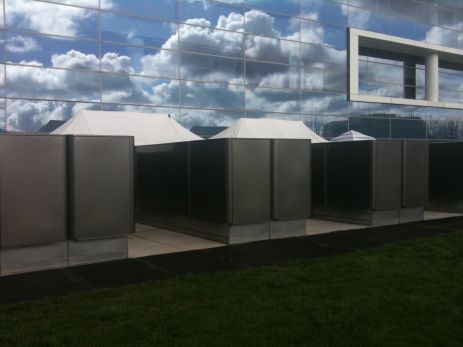 The Bloom Energy Servers installed at eBay’s headquarters in San Jose. Photo: Todd WoodyGreen tech had its Google moment this week in Silicon Valley when one of the most secretive and well-funded startups around, Bloom Energy, literally lifted the curtain on what it claims is a breakthrough in fuel cell technology: affordable electricity! Fewer greenhouse gas emissions! And that’s all before they throw in the bamboo steamer.
The Bloom Energy Servers installed at eBay’s headquarters in San Jose. Photo: Todd WoodyGreen tech had its Google moment this week in Silicon Valley when one of the most secretive and well-funded startups around, Bloom Energy, literally lifted the curtain on what it claims is a breakthrough in fuel cell technology: affordable electricity! Fewer greenhouse gas emissions! And that’s all before they throw in the bamboo steamer.
After eight years in stealth mode — until this week, Bloom’s website featured the company’s name and little else — the startup pulled out the stops in a carefully stage-managed media blitz that recalled the high-flying dot-com days of a decade ago. First came a report on “60 Minutes” that got the blogs abuzz along with stories in Fortune and The New York Times.
It all culminated in a star-studded press conference at eBay’s headquarters in San Jose on Wednesday, where California Governor Arnold Schwarzenegger introduced Bloom’s co-founder and chief executive, K.R. Sridhar, and gave him a bear hug before several hundred suits, environmental movement honchos and a bank of television cameras.
Before Colin Powell, the former secretary of state and a Bloom board member, delivered the benediction, testimonials were offered by Google co-founder Larry Page and top executives from Wal-Mart, eBay, Federal Express, Coca-Cola, and other Fortune 500 companies that had quietly purchased 100-kilowatt Bloom Energy Servers over the past year.
New York Mayor Michael Bloomberg and Senator Dianne Feinstein (D-Calif.), meanwhile, beamed in a bipartisan endorsement via video.
“This technology is going to fundamentally change the world,” the California Democrat declared.
But is it?
That’s the $400 million question (what some of Silicon Valley’s most storied venture capitalists have poured into Bloom so far).
With the hype — the apparently brilliant but unassuming Sridhar was compared to Steve Jobs at one point Wednesday — comes the backlash. Almost immediately analysts and competitors began asking hard questions about Bloom’s claims.
And there are some big unknowns. Will the fuel cell stacks last as long as the company anticipates or will frequent replacement undermine the economics of going off the grid, for both Bloom and their customers?
What’s the total cost of ownership for customers? Bloom says the energy servers have a lifespan of 10 years and a payback period of three to five years. That’s based on the current price of natural gas — which is one fuel used by the devices — and state and federal subsidies that halve the cost of the machines that sell for between $700,000 and $800,000. Will Bloom be able to scale up manufacturing and continue to innovate to bring the price of the energy server down? Can they be competitive without subsidies?
All legitimate questions. But it’s important not to lose sight of what looks to be some fundamental breakthroughs, not only in energy technology but in the way some major corporate players are embracing distributed generation-placing electricity production where it is consumed.
Fuel cells convert hydrogen, natural gas, or another fuel into electricity through an electrochemical process that results in reduced greenhouse gas emissions.
For decades scientists have sought to create a solid oxide fuel cell that can operate at extremely high temperatures-around 800 degrees C. That increases efficiency and eliminates the need for expensive precious metals and rare earth elements required as catalysts in lower-temperature fuel cells.
The challenge has been to engineer fuels cells that can withstand such high temperatures without cracking or leaking. UTC Power, the leading fuel cell maker, for instance, has spent three decades trying to perfect a cost-competitive and durable solid oxide fuel cell.
Bloom says it cracked the code by using a combination of common materials like sand and proprietary technology.
“What we have today is a very sellable product and that’s why people are buying it,” Sridhar, a 49-year-old former NASA scientist, said as he gave me a tour of company’s manufacturing operations before Wednesday’s unveiling of the Bloom Box.
One side of the building located in a non-descript Silicon Valley office park resembles a semiconductor clean room. Thin ceramic fuel cells the size of floppy disks shuffle through machines that paint them with green and black inks that serve as the devices’ anodes and cathodes, respectively. Next door, workers assemble 25-watt fuel cells into one-kilowatt stacks that are inserted into a metal cylinder, which in turn is placed into a silver metal cube.
In another area of the office, employees monitor the 30 Bloom Energy Servers in operation at companies around California. On one screen, video of a Bloom Box installed at Google appears along with a stream of data.
“Customers like Wal-Mart believe in doing the green thing but they absolutely believe in the bottom line,” says Sridhar. “The technology had to pass the muster and the muster simply was the rate of return on the investment.”
As the world’s largest corporation, Wal-Mart alone could be the key to giving Bloom and its many competitors a market to drive down costs and continue innovating.
“We would like to be able to do this at scale,” Bill Simon, Wal-Mart’s chief operating officer, said on Wednesday in San Jose, noting the company had installed Bloom Boxes at two of its California stores. (Wal-Mart on Thursday announced that it is requiring its suppliers to cut 20 million metric tons of greenhouse gas emissions by 2015. As one speaker at the Cleantech Forum confab in San Francisco on Thursday noted, Wal-Mart has the heft to set global climate change policy while governments dither.)
Sridhar says the Bloom Energy Server generates electricity at 50 percent to 55 percent efficiency, which is about twice as efficient as the overall power grid. Unlike competing systems, the Bloom Box will not repurpose excess heat to warm buildings and water, which can raise the overall energy efficiency of fuel cells to 90 percent. The tradeoff is that installing so-called combined heat and power systems is an expensive and months-long process.
The Bloom Box is plug and play — “power in hours,” as company executives like to say. That removes hurdles from the deployment of widespread distributed generation.
“I’d love to see us have a whole data center running on this at some point when they’re ready,” Google’s Larry Page said Wednesday. “Moving production of energy closer to where it’s used has a lot of environmental benefits and a lot of commercial benefits. It lets you choose your fuel source.”
There’s been much debate about the environmental impact of the Bloom fuel cells. Most will use natural gas and thus emit carbon dioxide, though much less than a typical fossil fuel power plant. If they use biogas — made from methane emitted by cow manure — carbon footprint drops to zero. But to have any meaningful impact, there will need to be a huge ramp up in biogas production .
But distributed generation, even when powered by natural gas, offers other environmental benefits. New transmission lines don’t need to be built — itself a carbon-intensive process — and you don’t lose efficiency by transmitting electricity from a distant power plant.
Rather than judge the Bloom Box unveiled Wednesday as a final product, it’s probably best to view it as the 1.0 version.
The pressure will be on Bloom to build cleaner and cleaner versions of its fuel cell if they are to be placed in cities and, as the company predicts, in backyards one day.
For instance, Bloom has patented and tested a next-generation fuel cell that would tap solar electricity from a rooftop array to produce hydrogen that could be stored and used to generate electricity at night or when the sun does not shine.
“That’s the killer app,” said Sridhar.
As he noted Wednesday, “Why clean? Is it because you’re an environmentalist? Because of regulation? No. For energy to be distributed it also has to be clean.”




